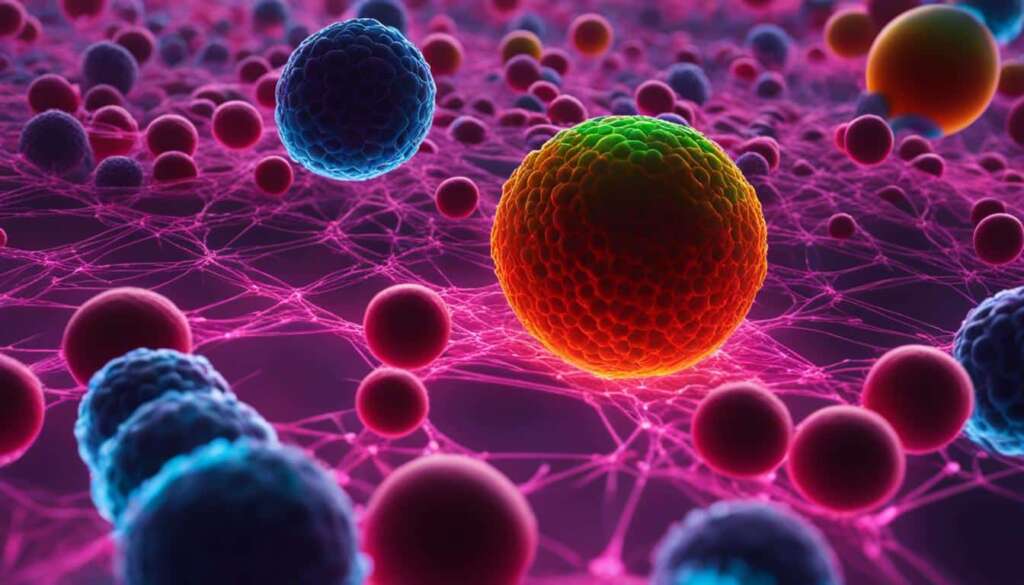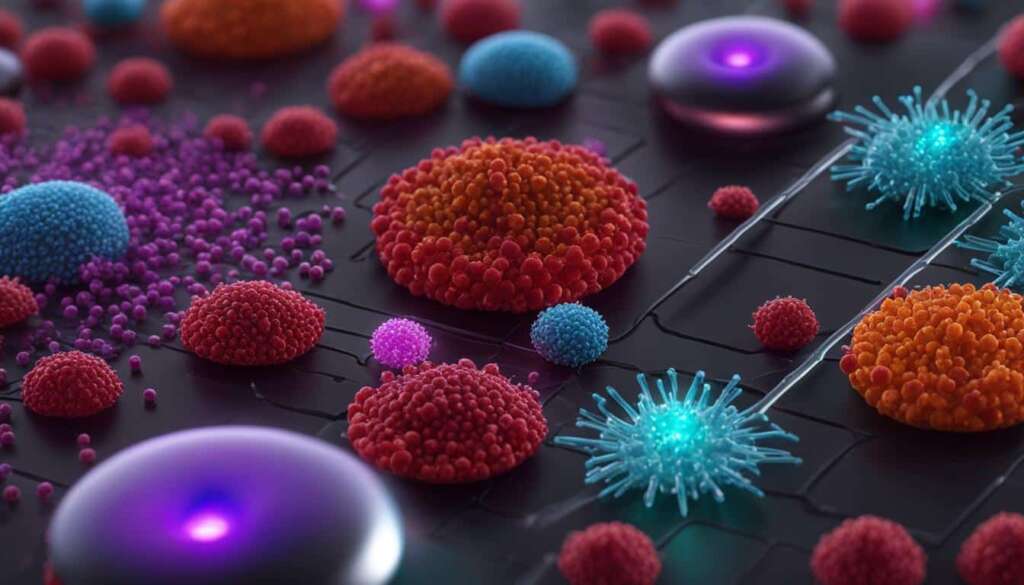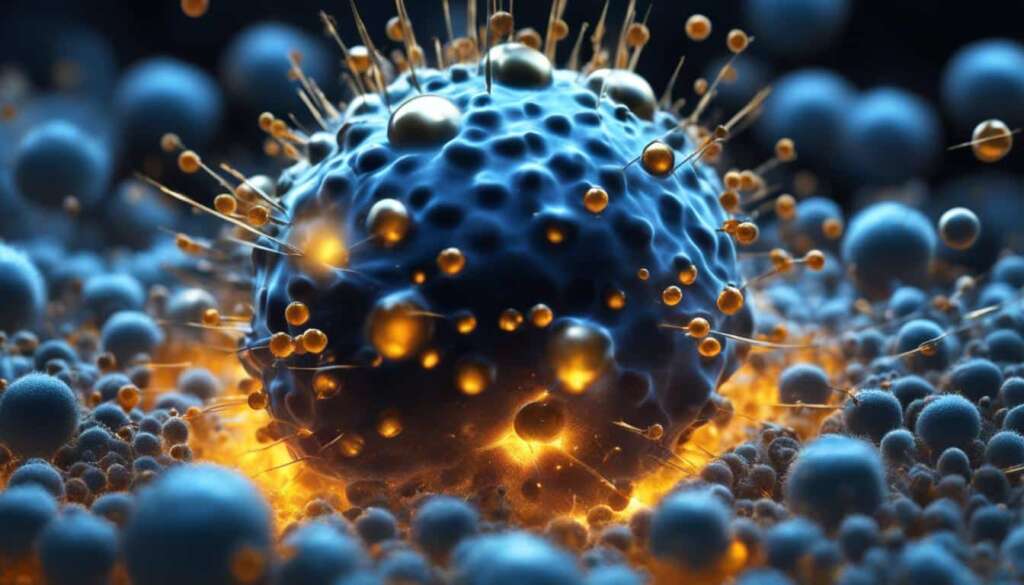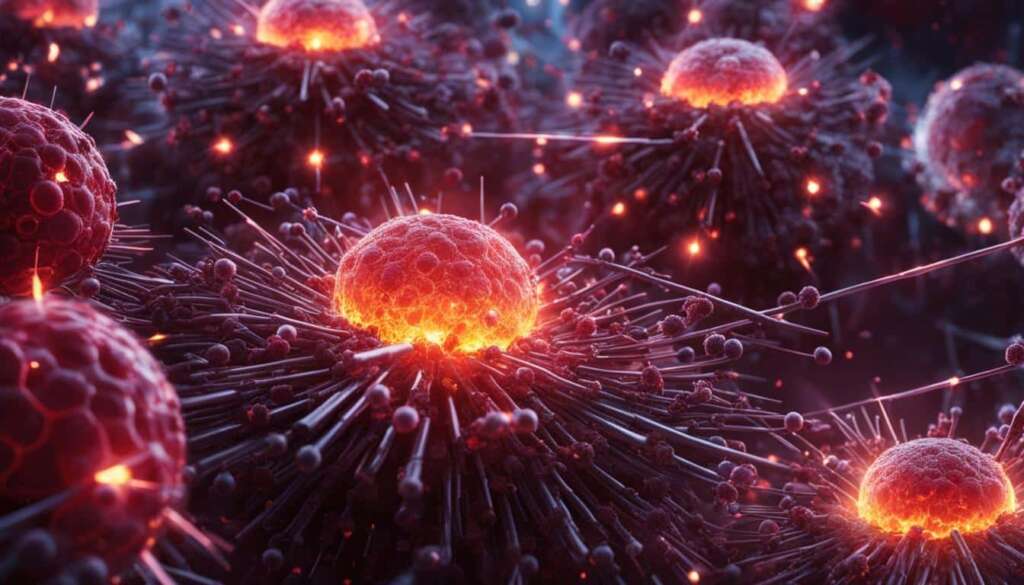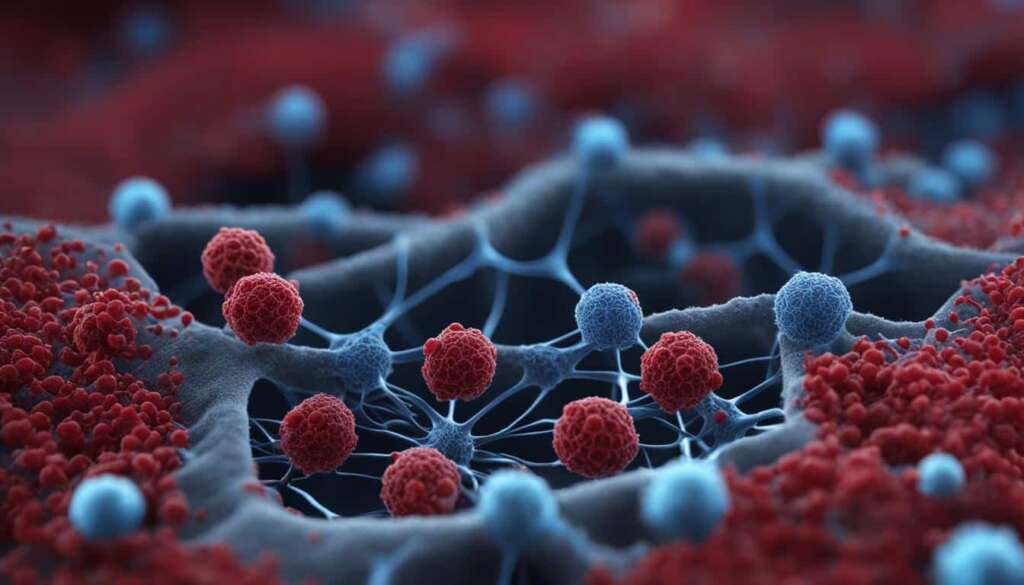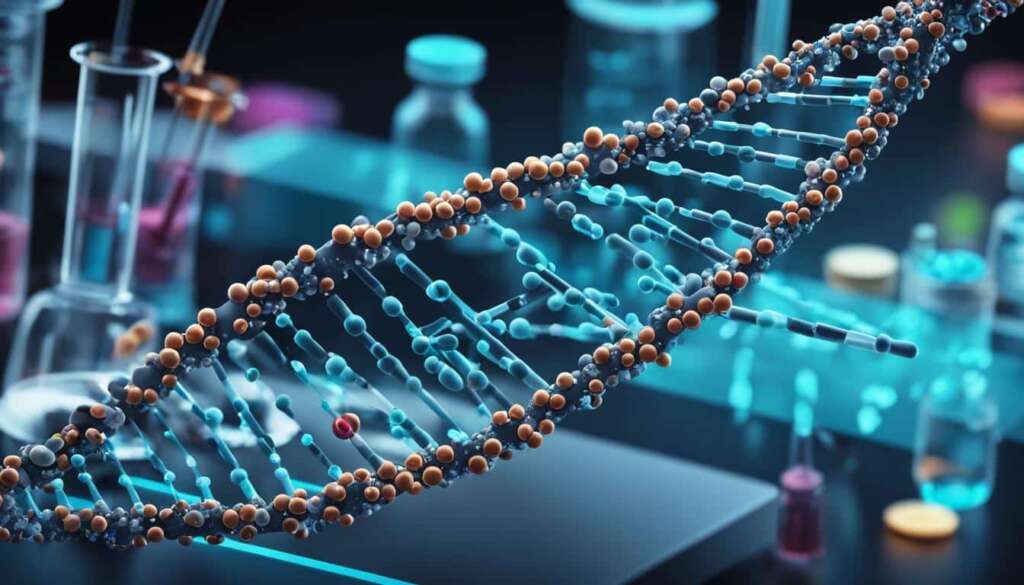Table of Contents
Nanotechnology holds immense promise for revolutionizing cancer treatment, offering new hope to patients around the world. With advancements in nanoscale targeting techniques, nanocarriers for targeted cancer therapy have emerged as a potential game-changer. This article explores the potential of nanotechnology in cancer treatment, highlighting the key findings and advancements in the field.
Key Takeaways
- Nanotechnology offers new hope for revolutionizing cancer treatment.
- Nanocarriers enable targeted drug delivery to cancer cells.
- Passive and active targeting strategies enhance the efficacy of nanocarrier-based cancer therapy.
- Overcoming challenges in translating nanocarrier-based therapies is essential for successful clinical applications.
- Approved nanocarriers, such as liposomes and nanoparticles, are being used in targeted cancer therapy.
Global Cancer Statistics and the Need for Innovative Treatment Approaches
Global cancer statistics paint a bleak picture, highlighting the urgent need for innovative approaches in cancer treatment. According to exhaustive research reports, cancer continues to be a significant health challenge worldwide, affecting millions of lives every year. Current treatment modalities, such as chemotherapy and radiation therapy, while effective in some cases, are often accompanied by severe side effects that can significantly impact patients’ quality of life.
The grim reality of cancer calls for transformative solutions– and this is where nanotechnology enters the scene. Nanotechnology offers a new ray of hope in the fight against cancer by leveraging cutting-edge advancements in science and engineering. By harnessing nanoscale materials, researchers are exploring novel treatment approaches that could potentially revolutionize cancer therapy for the better.
By targeting cancer cells specifically, nanotechnology-based treatment approaches aim to enhance treatment efficacy while minimizing the harmful side effects associated with conventional therapies. This targeted precision allows for the delivery of therapeutic agents directly to cancerous cells, increasing the therapy’s effectiveness while reducing the impact on healthy cells. The result is not only a potential reduction in side effects, but also an improvement in treatment outcomes.
| Global Cancer Statistics | Innovative Treatment Approaches |
|---|---|
| Cancer remains a major health concern worldwide, affecting millions of lives annually. | Nanotechnology-based treatment approaches offer new hope for improving cancer therapy. |
| Current treatment modalities have limitations, including severe side effects. | Nanotechnology enables targeted drug delivery, enhancing treatment efficacy while minimizing side effects. |
| Nanotechnology holds promise in revolutionizing cancer treatment by addressing the shortcomings of conventional methods. | Precise targeting of cancer cells allows for personalized and effective therapy. |
It is crucial to recognize the significant impact that nanotechnology can have on cancer treatment. As we delve into the intricacies of nanocarriers and their applications in cancer therapy, it becomes evident that novel treatment approaches are essential to meet the challenges posed by this formidable disease. The innovative potential of nanotechnology provides hope for patients and healthcare providers alike, driving the pursuit of improved treatment outcomes and a brighter future in the battle against cancer.
Nanocarriers for Targeted Drug Delivery in Cancer Treatment
Nanocarriers, such as liposomes, nanoparticles, and micelles, have shown great potential for targeted drug delivery in cancer treatment. These carriers can encapsulate therapeutic agents like drugs or genes and provide several advantages in the fight against cancer.
One of the key advantages of nanocarriers is their ability to precisely target cancer cells. By exploiting the unique properties of nanoscale materials, nanocarriers can be engineered to recognize specific cell surface markers found on cancer cells. This targeted approach allows for the selective delivery of therapeutics to tumor sites, enhancing the effectiveness of cancer treatment while minimizing damage to healthy cells.
Reducing toxicity to healthy cells is crucial in cancer treatment. Conventional chemotherapy often leads to undesirable side effects due to the systemic distribution of drugs throughout the body. Nanocarriers offer a solution by acting as protective carriers that shield the drug payload from interacting with healthy cells until they reach the tumor microenvironment.
Additionally, nanocarriers can improve drug efficacy. They can protect drug molecules from degradation and clearance mechanisms, enabling higher drug concentrations to accumulate at the target site. This results in improved therapeutic outcomes and lower effective drug doses, minimizing potential side effects for patients.
Overall, nanocarriers hold immense promise in the field of cancer treatment by facilitating targeted drug delivery, reducing toxicity to healthy cells, and improving drug efficacy. The development and optimization of nanocarriers continue to push the boundaries of cancer therapy, offering new hope to patients around the world.
The Advantages of Nanocarriers in Cancer Treatment:
- Precise targeting of cancer cells
- Reduced toxicity to healthy cells
- Improved drug efficacy
- Protection of drug molecules from degradation
- Lower effective drug doses and minimized side effects
Passive and Active Targeting in Nanocarrier-Based Cancer Therapy
In nanocarrier-based cancer therapy, both passive targeting and active targeting strategies are employed. Passive targeting takes advantage of the leaky blood vessels present in tumors, allowing nanocarriers to accumulate selectively in the tumor microenvironment. This phenomenon, known as the enhanced permeability and retention (EPR) effect, is a result of abnormal angiogenesis in cancerous tissues. The EPR effect enables nanocarriers to passively penetrate the tumor tissue and release therapeutic agents at the site of action.
On the other hand, active targeting involves modifying the surface of nanocarriers with targeting ligands that bind to specific receptors on cancer cells. By incorporating ligands such as antibodies, peptides, or aptamers, nanocarriers can actively engage with cancer cells, increasing cellular uptake and enhancing treatment efficacy. These ligands recognize and bind to overexpressed receptors found on cancer cells, enabling precise and targeted delivery of therapeutic agents.
The table below summarizes the differences between passive and active targeting in nanocarrier-based cancer therapy:
| Passive Targeting | Active Targeting |
|---|---|
| Exploits the EPR effect | Incorporates targeting ligands |
| Selective accumulation of nanocarriers in tumor microenvironment | Enhanced cellular engagement and uptake |
| Dependent on leaky blood vessels in tumors | Relies on specific receptor-ligand interactions |
| No active guidance to tumor cells | Precise delivery to cancer cells |
Both passive and active targeting strategies contribute to the efficacy and specificity of drug delivery in nanocarrier-based cancer therapy. By leveraging the unique characteristics of tumors and using specific ligands, nanocarriers can deliver therapeutic agents directly to cancer cells, minimizing off-target effects and improving treatment outcomes.
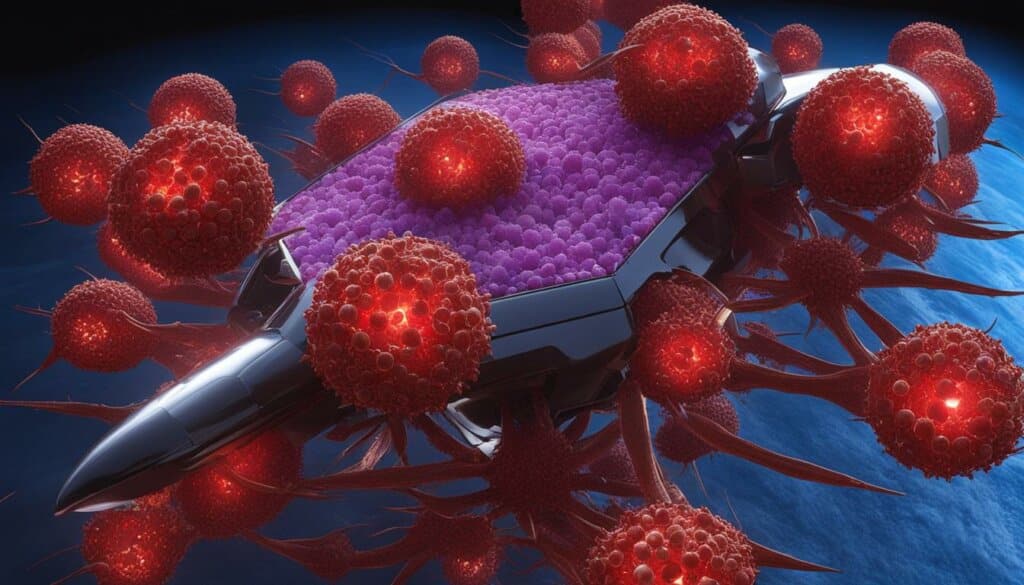
Overcoming Challenges in Translating Nanocarrier-Based Cancer Therapies
Despite the promising potential of nanocarrier-based cancer therapies, there are challenges in translating laboratory findings to clinical applications. The development of cost-effective and efficient nanocarriers, ensuring safety in human settings, and overcoming barriers to clinical translation are among the key challenges faced in this field. Further research is needed to optimize nanocarrier-based therapies and address these challenges to improve cancer treatment.
Nanotechnology has the potential to revolutionize cancer treatment through targeted drug delivery systems. However, there are certain obstacles that need to be overcome to ensure the successful implementation of nanocarrier-based therapies in clinical settings.
Development of Cost-Effective and Efficient Nanocarriers
One of the primary challenges is the development of nanocarriers that are both cost-effective and efficient. While nanocarriers offer targeted drug delivery to cancer cells, their manufacturing and production costs can be prohibitively high. To make nanocarrier-based therapies more accessible and affordable, researchers need to focus on developing cost-effective fabrication techniques and scalable production methods.
Ensuring Safety in Human Settings
Another significant challenge is ensuring the safety of nanocarrier-based therapies in human settings. While nanocarriers are designed to selectively target cancer cells, there is a need to ensure minimal off-target effects and toxicity to healthy tissues. The biocompatibility and long-term safety profile of nanocarriers must be thoroughly evaluated through preclinical and clinical trials to ensure patient safety and minimize potential side effects.
Overcoming Barriers to Clinical Translation
Translating nanocarrier-based cancer therapies from the laboratory to clinical practice poses its own set of challenges. Regulatory approval processes, intellectual property issues, and the integration of nanocarrier-based therapies into existing healthcare systems require careful consideration. Overcoming these barriers involves collaboration between researchers, clinicians, regulatory authorities, and pharmaceutical companies to streamline the translation process and ensure widespread adoption of these innovative therapies.
Addressing these challenges is crucial to unlock the full potential of nanocarrier-based cancer therapies. Through continued research and innovation, scientists and healthcare professionals can overcome these obstacles and pave the way for the future of personalized, targeted, and effective cancer treatment.
Approved Nanocarriers for Targeted Cancer Therapy
While several nanocarriers have undergone preclinical phases and human trials, only a few have been authorized for clinical use in targeting cancer cells. Notable approved nanocarriers include liposomes, nanoparticles, and micelles. These nanocarriers have demonstrated efficacy in selectively targeting tumors and delivering therapeutic agents, paving the way for improved cancer treatment options.
One of the most widely studied and approved nanocarriers for targeted cancer therapy is liposomes. Liposomes are spherical lipid-based vesicles that can encapsulate and deliver various types of drugs. Due to their biocompatibility and unique structure, liposomes have proven to be effective in delivering chemotherapy drugs directly to tumor sites while minimizing systemic toxicity to healthy tissues.
Nanoparticles are another category of approved nanocarriers used in targeted cancer therapy. These particles, typically ranging in size from 1 to 100 nanometers, can be engineered to carry therapeutic payloads and selectively accumulate at tumor sites. Their small size enables them to penetrate tumor tissues more effectively and deliver drugs directly to cancer cells. Additionally, nanoparticles can be surface-modified with targeting ligands to further enhance their efficacy in specific tumor types.
Micelles, formed by self-assembling amphiphilic molecules, are also approved nanocarriers utilized in targeted cancer therapy. These nanoscale structures have a hydrophilic shell and a hydrophobic core, allowing them to encapsulate hydrophobic drugs and improve their solubility in aqueous environments. Micelles can accumulate in tumor tissues through passive targeting mechanisms, taking advantage of the enhanced permeability and retention (EPR) effect often observed in solid tumors.
Overall, approved nanocarriers, such as liposomes, nanoparticles, and micelles, offer targeted cancer therapy solutions that hold great promise for improving treatment outcomes. These nanocarriers provide a means to overcome the limitations of conventional chemotherapy and enhance the efficiency and specificity of drug delivery to cancer cells.

| Nanocarrier | Advantages | Example Applications |
|---|---|---|
| Liposomes |
|
|
| Nanoparticles |
|
|
| Micelles |
|
|
Advances in Nanocarrier-Based Cancer Therapies
Significant advances have been made in nanocarrier-based cancer therapies, revolutionizing the field of cancer treatment. These advancements offer new possibilities for personalized and targeted approaches to fighting cancer.
Ligand-installed nanocarriers for precise tumor targeting: Researchers have developed nanocarriers equipped with specific ligands that enable precise targeting of tumor cells. These ligands can bind to receptors expressed on cancer cells, increasing the accumulation of therapeutics at the tumor site while minimizing systemic exposure. This targeted approach enhances the effectiveness of cancer treatment, reducing off-target effects and improving patient outcomes.
Stimuli-responsive liposomes for controlled drug release: Liposomes, a type of nanocarrier, can be engineered to respond to various stimuli present in the tumor microenvironment. By incorporating stimuli-responsive components, such as pH-sensitive polymers or temperature-sensitive lipids, liposomes can release therapeutic agents selectively in response to specific conditions within the tumor. This controlled drug release improves the efficacy of treatment while minimizing side effects.
Nanocarriers in immunotherapy and gene regulation: Nanocarriers are also being explored for their potential in immunotherapy and gene regulation. Researchers are investigating the use of nanocarriers to deliver immunotherapeutic agents, such as checkpoint inhibitors or CAR-T cells, directly to the tumor site. Additionally, nanocarriers can be utilized to deliver gene editing tools, enabling precise modulation of gene expression in cancer cells. These applications demonstrate the versatility of nanocarriers in advancing innovative cancer treatment strategies.
“The development of ligand-installed nanocarriers, stimuli-responsive liposomes, and the application of nanocarriers in immunotherapy and gene regulation have significantly advanced the field of nanocarrier-based cancer therapies.”
These advances in nanocarrier-based cancer therapies hold great promise for improving treatment outcomes and patient quality of life. The ability to target tumors specifically, control drug release, and harness the power of immunotherapy and gene regulation revolutionizes cancer treatment approaches.
Future Perspectives and Potential Applications of Nanotechnology in Cancer Treatment
The future of nanotechnology in cancer treatment holds great promise. Ongoing research aims to overcome current limitations and optimize the therapeutic potential of nanocarriers. With continued advancements, nanotechnology has the potential to transform cancer treatment.
Potential Applications
- Nanomedicines: Nanotechnology enables the development of nanomedicines, which are tailored to target and treat cancer cells more effectively. These nanocarriers can deliver therapeutic agents precisely to tumor sites, minimizing damage to healthy cells and reducing side effects.
- Combination Therapies: Nanocarriers offer the opportunity for combination therapies, where multiple therapeutic agents can be delivered simultaneously to enhance treatment efficacy. This approach can help overcome drug resistance and improve patient outcomes.
- Early Cancer Detection: Nanotechnology also holds potential in the field of early cancer detection. Nanosensors and nanoparticles can be used to detect biomarkers associated with cancer, enabling the early identification and diagnosis of tumors.
Transforming Cancer Treatment
The integration of nanotechnology in cancer treatment has the potential to revolutionize current approaches. By overcoming existing limitations, such as off-target effects and drug resistance, nanocarriers can provide more targeted and personalized therapeutic strategies. The use of nanomedicines, combination therapies, and early cancer detection techniques can significantly improve patient outcomes and survival rates.
To illustrate the impact of nanotechnology in cancer treatment, consider the following real-world example:
“Nanoparticles loaded with anti-cancer drugs have been successful in targeting and destroying tumor cells while sparing healthy tissue. This breakthrough has paved the way for more efficient and less toxic cancer treatments.” – Dr. Jane Wilson, Nanomedicine Researcher
Nanotechnology has the potential to transform cancer treatment by offering innovative solutions for improved drug delivery, enhanced targeting specificity, and early disease detection. The future of nanotechnology in cancer treatment holds immense promise for improving patient outcomes and bringing new hope to those affected by this devastating disease.
Potential Applications of Nanotechnology in Cancer Treatment
| Application | Description |
|---|---|
| Nanomedicines | Nanocarriers for targeted drug delivery to tumor sites, minimizing side effects. |
| Combination Therapies | Simultaneous delivery of multiple therapeutic agents to overcome drug resistance. |
| Early Cancer Detection | Utilizing nanosensors and nanoparticles to detect cancer biomarkers for early diagnosis. |
Marketed Nanocarriers and Clinical Trials in Cancer Therapy
Several nanocarriers have been marketed for cancer therapy, while others are still in various stages of clinical trials. Marketed nanocarriers include liposomes, metallic nanoparticles, and smart nanocarriers for targeted drug delivery.
These marketed nanocarriers have shown promising results in delivering therapeutics specifically to cancer cells, enhancing the efficacy of treatment while minimizing damage to healthy tissues.
In addition to marketed nanocarriers, extensive research is ongoing through clinical trials to explore the effectiveness and safety of nanocarrier-based therapies in treating various types of cancer.
Researchers are investigating the potential of nanocarriers to revolutionize cancer therapy by improving drug delivery, reducing side effects, and enhancing treatment outcomes. Clinical trials play a crucial role in evaluating the efficacy and safety of these innovative approaches.
These ongoing efforts contribute to the growing body of evidence supporting the use of nanotechnology in cancer therapy, bringing hope to patients and healthcare professionals alike.

| Nanocarrier | Targeted Drug Delivery | Advantages |
|---|---|---|
| Liposomes | Encapsulates drugs for precise targeting | Reduces toxicity to healthy cells |
| Metallic nanoparticles | Carries therapeutic agents to specific tumor sites | Improves treatment efficacy |
| Smart nanocarriers | Responds to stimuli to release drugs at desired locations | Enhances localization and effectiveness |
Ongoing Clinical Trials
Ongoing clinical trials aim to further validate the effectiveness and safety of nanocarrier-based therapies in cancer treatment. These trials assess different aspects, including dosing regimens, treatment response rates, and long-term outcomes.
Some notable clinical trials investigating nanocarrier-based cancer therapies include:
- Phase 3 clinical trial evaluating the efficacy of liposomal doxorubicin in breast cancer patients.
- Phase 2 trial assessing the use of metallic nanoparticles for targeted drug delivery in lung cancer treatment.
- Phase 1 study investigating the safety and potential of smart nanocarriers loaded with immunotherapeutic agents in melanoma patients.
These clinical trials provide critical insights into the potential of nanocarrier-based therapies and pave the way for their implementation in mainstream cancer treatment protocols.
Advantages and Potential of Nanocarrier-Based Cancer Therapies
Nanocarrier-based cancer therapies offer several advantages over conventional treatments. These include:
- Improved drug delivery to tumor sites
- Reduced toxicity to healthy cells
- Enhanced treatment efficacy
- Potential for personalized medicine
Nanocarriers can be tailored to specific tumor characteristics, enabling precise and targeted therapy. By encapsulating therapeutic agents within nanoscale carriers, drugs can be delivered directly to cancer cells, maximizing their effectiveness while minimizing damage to healthy cells.
The potential of nanotechnology in cancer treatment is vast. With ongoing research and advancements, nanocarrier-based therapies offer new avenues for developing innovative treatment approaches and improving patient outcomes. The versatility of nanocarriers allows for the exploration of various targeted drug delivery strategies, such as combination therapies and immunotherapy.
Personalized Medicine and Targeted Therapy
“The use of nanocarriers in cancer treatment opens up possibilities for personalized medicine, where treatments can be tailored to individual patients based on their unique tumor characteristics.” — Dr. Sarah Thompson, Oncology Researcher
With the ability to tailor nanocarriers to specific tumor characteristics, personalized medicine becomes a reality. By incorporating targeting ligands or antibodies on the surface of nanocarriers, treatment can be precisely directed towards cancer cells, improving efficacy and minimizing side effects.
Nanocarrier-based cancer therapies have the potential to revolutionize treatment outcomes and offer new hope to patients. Continued research and development in this field will pave the way for innovative approaches and customizable treatment regimens.
| Advantages of Nanocarrier-Based Cancer Therapies | Potential Applications |
|---|---|
| Improved drug delivery to tumor sites | Treatment optimization for different cancer types |
| Reduced toxicity to healthy cells | Development of personalized nanomedicines |
| Enhanced treatment efficacy | Nanocarriers for combination therapies |
| Potential for personalized medicine | Nanotechnology in early cancer detection |
Conclusion
The utilization of nanotechnology in cancer treatment holds immense promise for improving patient outcomes. By leveraging the targeted drug delivery capabilities of nanocarriers, this innovative approach offers new hope for effective cancer therapy. Despite the challenges that need to be addressed, ongoing research and advancements in nanocarrier-based therapies are paving the way for transformative treatments.
Nanotechnology holds the potential to revolutionize cancer treatment by enhancing drug efficacy and minimizing side effects. The precise targeting of cancer cells and the reduced toxicity to healthy cells provided by nanocarriers offer significant advantages over conventional therapies. Through further exploration and optimization, nanotechnology has the potential to transform cancer treatment, providing patients with targeted and more effective care.
As nanotechnology continues to evolve, it opens up new avenues for personalized medicine and tailored treatment. The development of nanomedicines, the exploration of combination therapies, and early cancer detection methods are just some of the exciting potential applications. With the ongoing advancements and dedication of researchers, the future of nanotechnology in cancer treatment looks promising, bringing hope to patients and their families around the world.
FAQ
What is nanotechnology?
Nanotechnology is a field of science and technology that focuses on manipulating matter at the nanoscale, which is the scale of atoms and molecules. It involves the understanding, manipulation, and control of matter at the nanoscale to create new materials and devices with unique properties and functionalities.
How does nanotechnology hold promise for cancer treatment?
Nanotechnology holds promise for cancer treatment due to its ability to precisely target cancer cells while minimizing side effects. Nanocarriers, such as liposomes and nanoparticles, can encapsulate therapeutic agents and selectively deliver them to tumor sites, improving treatment efficacy and reducing toxicity to healthy cells.
What are nanocarriers?
Nanocarriers are microscopic particles or structures that can encapsulate therapeutic agents, such as drugs or genes, and transport them to specific locations in the body. They are designed to enhance drug delivery, improve treatment efficacy, and minimize side effects by targeting specific cells or tissues, such as cancer cells.
What are passive and active targeting strategies in nanocarrier-based cancer therapy?
Passive targeting takes advantage of the leaky blood vessels present in tumors, allowing nanocarriers to accumulate selectively in the tumor microenvironment. Active targeting involves modifying the surface of nanocarriers with targeting ligands that bind to specific receptors on cancer cells, leading to enhanced cellular engagement. These strategies improve the efficacy and specificity of drug delivery in cancer therapy.
What are the challenges in translating nanocarrier-based cancer therapies to clinical applications?
The challenges in translating nanocarrier-based cancer therapies to clinical applications include the development of cost-effective and efficient nanocarriers, ensuring safety in human settings, and overcoming barriers to clinical translation. Further research is needed to optimize nanocarrier-based therapies and address these challenges to improve cancer treatment.
What are some approved nanocarriers for targeted cancer therapy?
Some approved nanocarriers for targeted cancer therapy include liposomes, nanoparticles, and micelles. These nanocarriers have demonstrated efficacy in selectively targeting tumors and delivering therapeutic agents, offering improved cancer treatment options.
What are some advances in nanocarrier-based cancer therapies?
Advances in nanocarrier-based cancer therapies include the development of ligand-installed nanocarriers for precise tumor targeting, the use of stimuli-responsive liposomes for controlled drug release, and the application of nanocarriers in immunotherapy and gene regulation. These advancements offer new possibilities for personalized and targeted cancer treatment.
What are the potential applications of nanotechnology in cancer treatment?
Potential applications of nanotechnology in cancer treatment include the development of nanomedicines, the use of nanocarriers for combination therapies, and the exploration of nanotechnology in early cancer detection. With continued advancements, nanotechnology has the potential to transform cancer treatment and provide new avenues for targeted and effective care.
What are the marketed nanocarriers and ongoing clinical trials in cancer therapy?
Marketed nanocarriers for cancer therapy include liposomes, metallic nanoparticles, and smart nanocarriers for targeted drug delivery. Ongoing clinical trials are exploring the effectiveness and safety of nanocarrier-based therapies in treating various types of cancer. These efforts contribute to the growing body of evidence supporting the use of nanotechnology in cancer treatment.
What are the advantages of nanocarrier-based cancer therapies?
Nanocarrier-based cancer therapies offer several advantages over conventional treatments. These include improved drug delivery to tumor sites, reduced toxicity to healthy cells, enhanced treatment efficacy, and the potential for personalized medicine. Nanocarriers can be tailored to specific tumor characteristics, enabling precise and targeted therapy.

